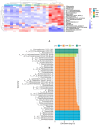Therapeutic effect of fecal microbiota transplantation on hyperuricemia mice by improving gut microbiota
- PMID: 40838009
- PMCID: PMC12361192
- DOI: 10.3389/fmicb.2025.1599107
Therapeutic effect of fecal microbiota transplantation on hyperuricemia mice by improving gut microbiota
Abstract
Objective: The primary objective of this study was to assess the impact of fecal microbiota transplantation (FMT) on serum biochemical parameters, renal injury, and gut microbiota in hyperuricemia (HUA) mice.
Methods: Six-week-old male C57BL/6 J mice were given a high-purine diet and potassium oxonate injections to induce HUA, followed by a two-week FMT treatment. Regular body weight checks, serum biochemical analyses, and fecal sampling for 16S rRNA gene sequencing were conducted to evaluate the treatment's impact on gut microbiota.
Results: The model group showed significant increases in uric acid (UA), creatinine (Cr), blood urea nitrogen (BUN) levels, and increased xanthine oxidase (XOD) activity compared to controls (p < 0.05). FMT treatment effectively reduced these levels and XOD activity (p < 0.05). At the genus level, specific taxa like Muribaculaceae and Prevotellaceae_UCG-001 were less abundant, while Blautia and Ruminiclostridium_9 were more abundant in the model group. Following FMT, gut microbiota composition returned to near-normal levels, with significant differences from the model group (p < 0.05).
Conclusion: This study demonstrates that FMT holds therapeutic potential for HUA mice by reducing UA levels, alleviating renal damage, and restoring gut microbiota balance.
Keywords: fecal microbiota transplantation; gut microbiota; hyperuricemia; microbiome; renal injury.
Copyright © 2025 Yuan, Jia, Liu, Liu, Cao, Wu, Li, Xu, Xiao, Hong and Zhang.
Conflict of interest statement
RL, MC, YW, YL, WX, CX, and BZ were employed by Xiamen Treatgut Biotechnology Co., Ltd. The remaining authors declare that the research was conducted in the absence of any commercial or financial relationships that could be construed as a potential conflict of interest.
Figures








Similar articles
-
Combination of Withania coagulans and Fagonia cretica ameliorates hyperuricemia by re-modulating gut microbiota-derived spermidine and traumatic acid.Phytomedicine. 2025 Sep;145:157079. doi: 10.1016/j.phymed.2025.157079. Epub 2025 Jul 17. Phytomedicine. 2025. PMID: 40712280
-
Efficacy and mechanisms of compound Bai Mao Yin in regulating uric acid transport and improving the intestinal microbiota to alleviate hyperuricemia via the enterorenal axis.Microb Pathog. 2025 Oct;207:107922. doi: 10.1016/j.micpath.2025.107922. Epub 2025 Jul 21. Microb Pathog. 2025. PMID: 40701508
-
Puerarin-rich compound Puerariae lobatae formulas alleviate hyperuricemia in mice by enhancing renal and intestinal function through regulating gut microbiota.Phytomedicine. 2025 Oct;146:157115. doi: 10.1016/j.phymed.2025.157115. Epub 2025 Aug 12. Phytomedicine. 2025. PMID: 40815946
-
Fecal microbiota transplantation for the treatment of recurrent Clostridioides difficile (Clostridium difficile).Cochrane Database Syst Rev. 2023 Apr 25;4(4):CD013871. doi: 10.1002/14651858.CD013871.pub2. Cochrane Database Syst Rev. 2023. PMID: 37096495 Free PMC article.
-
[Association between gut microbiota and hyperuricemia: insights into innovative therapeutic strategies].Sheng Wu Gong Cheng Xue Bao. 2025 Jun 25;41(6):2290-2309. doi: 10.13345/j.cjb.250060. Sheng Wu Gong Cheng Xue Bao. 2025. PMID: 40550671 Review. Chinese.
References
-
- Amatjan M., Li N., He P., Zhang B., Mai X., Jiang Q., et al. (2023). A novel approach based on gut microbiota analysis and network pharmacology to explain the mechanisms of action of cichorium intybus l. formula in the improvement of hyperuricemic nephropathy in rats. Drug Des. Devel. Ther. 17, 107–128. doi: 10.2147/DDDT.S389811, PMID: - DOI - PMC - PubMed
LinkOut - more resources
Full Text Sources

